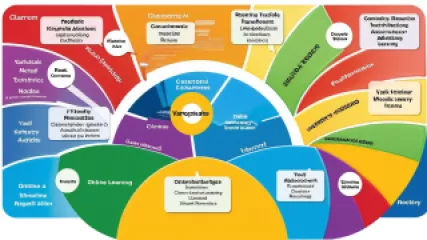Discover Your Optimal Learning Style: A Step-by-Step Guide
Discover Your Optimal Learning Style: A Step-by-Step Guide
Are you someone who struggles to retain information or find it challenging to engage with certain learning materials? The secret to effective and enjoyable learning may lie in understanding your unique learning style. By discovering your optimal learning approach, you can unlock a world of educational opportunities and reach your full potential.
In this comprehensive guide, we'll explore the different learning styles, uncover the VARK model, and provide you with a step-by-step process to identify your personal learning preferences. Whether you're a student, a lifelong learner, or simply seeking to enhance your knowledge and skills, this article will empower you to tailor your learning experience and maximize your growth.
The Importance of Understanding Learning Styles
Learning is a complex and highly personal process, and each individual has their own unique way of absorbing, processing, and retaining information. Recognizing your learning style is crucial because it allows you to adapt your study methods, learning materials, and overall approach to best suit your individual needs.
By understanding your learning preferences, you can:
- Improve Retention and Comprehension: When you learn in a way that aligns with your natural inclinations, you're more likely to remember and apply the information effectively.
- Increase Motivation and Engagement: Learning in a style that resonates with you can make the process more enjoyable and fulfilling, leading to greater motivation and a deeper level of engagement.
- Develop Personalized Study Strategies: Knowing your learning style allows you to tailor your study techniques, such as creating visual aids, engaging in hands-on activities, or recording audio lectures.
- Adapt to Different Learning Environments: Whether you're in a traditional classroom, a virtual setting, or a self-paced learning program, being aware of your learning style can help you navigate and thrive in various educational contexts.
Embracing your learning style is the key to unlocking your full academic and personal growth potential. By aligning your learning approach with your natural preferences, you'll not only enhance your knowledge retention but also cultivate a lifelong love of learning.
Exploring the VARK Model of Learning Styles
One of the most widely recognized and extensively studied models of learning styles is the VARK framework, developed by Neil Fleming. This model categorizes learners into four main types based on their primary sensory preferences:
Visual (V)
Visual learners thrive on the use of images, diagrams, charts, and other visual aids. They tend to remember information better when it is presented in a visual format, such as color-coded notes, mind maps, or infographics.
Auditory (A)
Auditory learners prefer to process information through sound and verbal explanations. They often benefit from listening to lectures, discussions, or audio recordings, and may find it helpful to read aloud or participate in group discussions.
Read/Write (R)
Read/write learners thrive on the written word, preferring to learn through reading and writing activities. They may enjoy taking detailed notes, creating outlines, or engaging in written exercises to solidify their understanding.
Kinesthetic (K)
Kinesthetic learners are hands-on, experiential learners who learn best through physical interaction and movement. They may enjoy role-playing, laboratory experiments, or hands-on projects that allow them to actively engage with the material.
It's important to note that many individuals exhibit a combination of these learning preferences, known as multimodal learning. In such cases, learners may benefit from a blend of visual, auditory, read/write, and kinesthetic approaches to optimize their learning experience.
Identifying Your Learning Style
Determining your learning style can be a transformative process, as it empowers you to tailor your learning strategies and create a more personalized educational experience. Follow these steps to uncover your optimal learning preferences:
Step 1: Assess Your Preferences
Begin by reflecting on how you tend to learn best. Consider the following questions:
- Do you prefer to learn through visual aids, such as diagrams, charts, or videos?
- Do you find it easier to remember information when you hear it spoken aloud or participate in discussions?
- Do you thrive on reading and writing activities, such as taking notes or creating summaries?
- Do you enjoy hands-on experiences, such as experiments, simulations, or practical applications?
Pay attention to the activities and learning materials that you find most engaging and effective. This will give you a good starting point for identifying your primary learning style.
Step 2: Take a Learning Style Assessment
While self-reflection can provide valuable insights, it's also helpful to take a formal learning style assessment. There are various online questionnaires and tests available, such as the VARK Questionnaire, that can help you determine your dominant learning preferences.
These assessments typically involve answering a series of questions about your learning preferences and behaviors. Based on your responses, the assessment will provide you with a detailed analysis of your learning style, including your strengths, weaknesses, and suggested study strategies.
Step 3: Experiment and Reflect
Once you have a general understanding of your learning style, experiment with different learning techniques and materials to confirm your preferences. Try taking notes in various formats, such as visual mind maps or audio recordings, and observe which methods help you retain information most effectively.
Additionally, pay attention to your level of engagement and enjoyment during different learning activities. The more you can align your learning approach with your natural inclinations, the more productive and fulfilling the learning process will be.
Step 4: Embrace Multimodal Learning
While it's valuable to identify your primary learning style, it's also important to recognize that you may exhibit a combination of preferences. Embracing a multimodal approach to learning can be incredibly beneficial, as it allows you to engage multiple senses and cater to the diverse ways in which your brain processes information.
Experiment with incorporating a variety of learning modalities into your study routine, such as creating visual aids, listening to audio recordings, and engaging in hands-on activities. This versatile approach can help you develop a well-rounded set of learning skills and adaptability to different educational contexts.
Tailoring Your Learning Strategies
Once you have a clear understanding of your learning style, it's time to optimize your learning strategies and create personalized study plans. Here are some tips to help you make the most of your preferred learning style:
Visual Learners
- Create detailed, color-coded notes, mind maps, or diagrams to visualize key concepts.
- Utilize visual aids, such as charts, graphs, and infographics, to supplement your learning materials.
- Seek out educational videos, presentations, or virtual simulations that allow you to see the content in action.
Auditory Learners
- Participate in class discussions, group study sessions, or virtual learning environments that facilitate verbal exchange.
- Record lectures or create audio recordings of yourself explaining key concepts to listen to later.
- Engage in reading aloud, either to yourself or with a study group, to solidify your understanding.
Read/Write Learners
- Take detailed, structured notes, either by hand or using digital tools, to organize and process information.
- Create outlines, summaries, or written explanations of the material to reinforce your understanding.
- Seek out learning resources that emphasize written content, such as textbooks, articles, or online courses with extensive reading material.
Kinesthetic Learners
- Engage in hands-on activities, such as experiments, simulations, or practical applications, to solidify your understanding.
- Incorporate movement or physical gestures into your learning process, such as pacing while reviewing material or acting out concepts.
- Seek out opportunities for field trips, internships, or real-world learning experiences that allow you to directly interact with the subject matter.
Multimodal Learning
If you find that you exhibit a combination of learning preferences, consider the following strategies to optimize your learning experience:
- Incorporate a variety of learning modalities into your study routine, such as visual aids, audio recordings, written summaries, and hands-on activities.
- Experiment with different learning techniques and observe which ones resonate with you the most, then integrate them into your personalized study plan.
- Seek out educational resources and learning environments that cater to diverse learning styles, such as multimedia-rich online courses or interactive classroom settings.
Embracing a multimodal approach to learning can be particularly beneficial in today's increasingly digital and technology-driven educational landscape. By leveraging a range of learning modalities, you can enhance your comprehension, retention, and overall academic or professional success.
Navigating Different Learning Environments
Understanding your learning style is not only valuable in academic settings but can also be beneficial in various professional and personal contexts. As you navigate different learning environments, consider the following strategies to optimize your experience:
Classroom Learning
In a traditional classroom setting, be proactive in communicating your learning preferences to your instructor. Inquire about the availability of visual aids, opportunities for class discussions, or possibilities for hands-on activities. Additionally, consider forming study groups with peers who share similar learning styles to collaborate and support one another.
Online and Virtual Learning
The rise of online and virtual learning has provided unprecedented access to educational resources, but it also requires learners to be more self-directed. Leverage the benefits of your learning style by seeking out online courses, webinars, or virtual counseling sessions that align with your preferences. For example, visual learners may thrive on interactive multimedia content, while auditory learners may benefit from video lectures or virtual discussions.
Workplace Learning and Professional Development
Learning doesn't stop once you enter the workforce. Ongoing professional development and on-the-job training are essential for career growth. Recognize your learning style and advocate for learning opportunities that cater to your preferences, such as hands-on workshops, peer-to-peer training sessions, or self-paced online modules.
Lifelong Learning
Embracing a lifelong learning mindset is crucial for personal growth and adaptability in an ever-evolving world. Whether you're pursuing a new hobby, exploring a subject of interest, or engaging in self-directed learning, be mindful of your learning style and seek out resources that align with your preferences. This will not only enhance your enjoyment of the learning process but also ensure that the knowledge and skills you acquire are truly impactful and long-lasting.
Conclusion
Discovering your optimal learning style is a transformative step in your educational and personal growth journey. By understanding how you best absorb, process, and retain information, you can tailor your learning strategies, create personalized study plans, and unlock new levels of academic and professional success.
Remember, there is no one-size-fits-all approach to learning. Embrace the diversity of learning styles and be open to experimenting with different techniques. By leveraging your unique strengths and preferences, you'll not only enhance your learning outcomes but also cultivate a lifelong love of knowledge and personal development.
Embark on this journey of self-discovery, and let your learning style be your guide to unlocking your full potential. Embrace the power of multimodal learning, navigate diverse educational environments, and continue to refine your strategies for optimal growth. The path to becoming a confident, engaged, and successful learner starts here.






